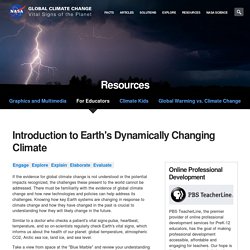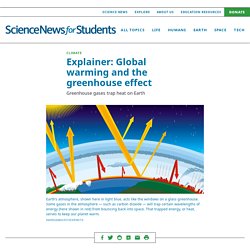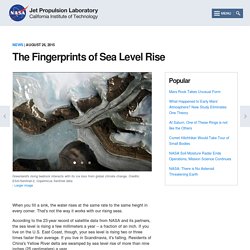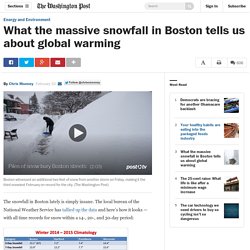

TFG ClimateChange Complete. How Zero-Waste People Make Only a Jar of Trash a Year. This story is part of Planet or Plastic?

—our multiyear effort to raise awareness about the global plastic waste crisis. Learn what you can do to reduce your own single-use plastics, and take your pledge. How to fit 4 years of trash into a mason jar, a zero waste experiment - The Kid Should See This. Impacts Videos - Our Climate Our Future. The Habitable Planet Unit 1 - Many Planets, One Earth // Online Textbook. Untitled. Climate Change: Vital Signs of the Planet: Engage: Changing Climate. If the evidence for global climate change is not understood or the potential impacts recognized, the challenges these present to the world cannot be addressed.

There must be familiarity with the evidence of global climate change and how new technologies and policies can help address its challenges. Knowing how key Earth systems are changing in response to climate change and how they have changed in the past is crucial to understanding how they will likely change in the future. Similar to a doctor who checks a patient's vital signs-pulse, heartbeat, temperature, and so on-scientists regularly check Earth's vital signs, which informs us about the health of our planet: global temperature, atmospheric CO2, Arctic sea ice, land ice, and sea level.
Take a view from space at the "Blue Marble" and review your understanding of the Earth as a system. Meanwhile, in the tropics, local communities face different climate-change related challenges. Science Bulletins: The Ecology of Climate Change. Interviewing tips. Plastic island: How our trash is destroying paradise. Lichens are an early warning system for forest health. View the slideshow Ecologist Linda Geiser works her way through thick undergrowth on the steep hills of the Bull Run Watershed just outside of Portland, Ore.

Every step in her heavy boots is deliberate. It would be easy to break an ankle here, or worse. A dense sea of ferns and berry bushes hides deep pits and sharp fallen branches. This treacherous slope is a U.S. Fringed and fuzzy, or as slick as a coat of paint, lichens are mosaics of fungi partnered with algae or cyanobacteria that speckle tree bark and dangle from the canopy (SN: 11/7/09, p. 16). “Where there is pollution, there is a predictable effect on lichens,” Geiser says. In the presence of high levels of excess nitrogen, moderately sensitive wolf lichens (Letharia vulpine, left) languish while candleflame lichens (Candelaria pacifica, right) thrive.
Explainer: Global warming and the greenhouse effect. Earth’s atmosphere works something like a giant glass greenhouse.

As the sun’s rays enter our atmosphere, most continue right down to the planet’s surface. As they hit the soil and surface waters, those rays release much of their energy as heat. Some of the heat then radiates back out into space. However, certain gases in our atmosphere, such as carbon dioxide, methane and water vapor, work like a blanket to retain much of that heat. This helps to warm our atmosphere. The consensus project. The 97% consensus on global warming. Science achieves a consensus when scientists stop arguing.

When a question is first asked – like ‘what would happen if we put a load more CO2 in the atmosphere?’ – there may be many hypotheses about cause and effect. Over a period of time, each idea is tested and retested – the processes of the scientific method – because all scientists know that reputation and kudos go to those who find the right answer (and everyone else becomes an irrelevant footnote in the history of science). Nearly all hypotheses will fall by the wayside during this testing period, because only one is going to answer the question properly, without leaving all kinds of odd dangling bits that don’t quite add up.
Bad theories are usually rather untidy. Oceans of Kansas Paleontology. After losing huge amount, Greenland ice is melting faster than ever. A new study has calculated just how much ice Greenland has lost since the year 1900.

The number is astounding: 9,103 gigatons. A gigaton is a billion metric tons. For reference, the Statue of Liberty weighs about 200 metric tons. The study was completed by 16 authors and was published in the magazine Nature. The lead author was Kristian K. Estimating the loss of ice was not easy. All were merged to provide the new ice loss estimates. How Greenland Affects Earth's Waters. The Fingerprints of Sea Level Rise. When you fill a sink, the water rises at the same rate to the same height in every corner.

That's not the way it works with our rising seas. According to the 23-year record of satellite data from NASA and its partners, the sea level is rising a few millimeters a year -- a fraction of an inch. If you live on the U.S. East Coast, though, your sea level is rising two or three times faster than average. If you live in Scandinavia, it's falling. These regional differences in sea level change will become even more apparent in the future, as ice sheets melt. Tides, winds and ocean currents play a role in these regional differences, but an increasingly important mover and shaker is the solid Earth itself.
Climate Change Animation Shows Devastating Effects. Treading Water - Map: The Cost of Climate Change in 2050. What the massive snowfall in Boston tells us about global warming. Boston witnessed an additional two feet of snow from another storm on Friday, making it the third snowiest February on record for the city.

(The Washington Post) The snowfall in Boston lately is simply insane. The local bureau of the National Weather Service has tallied up the data and here’s how it looks — with all time records for snow within a 14-, 20-, and 30-day period: You could treat this as ordinary weather, or, you could think about it in a climate context. Counter-intuitive though it may sound, the fact remains that — as I have noted previously — some kinds of winter precipitation could indeed be more intense because we’re in a warming world. Consider, for instance, that sea surface temperatures off the coast of New England are flashing red, showing an extreme warm anomaly. “Sea surface temperatures off the coast of New England right now are at record levels, 11.5C (21F) warmer than normal in some locations,” says Penn State climate researcher Michael Mann.